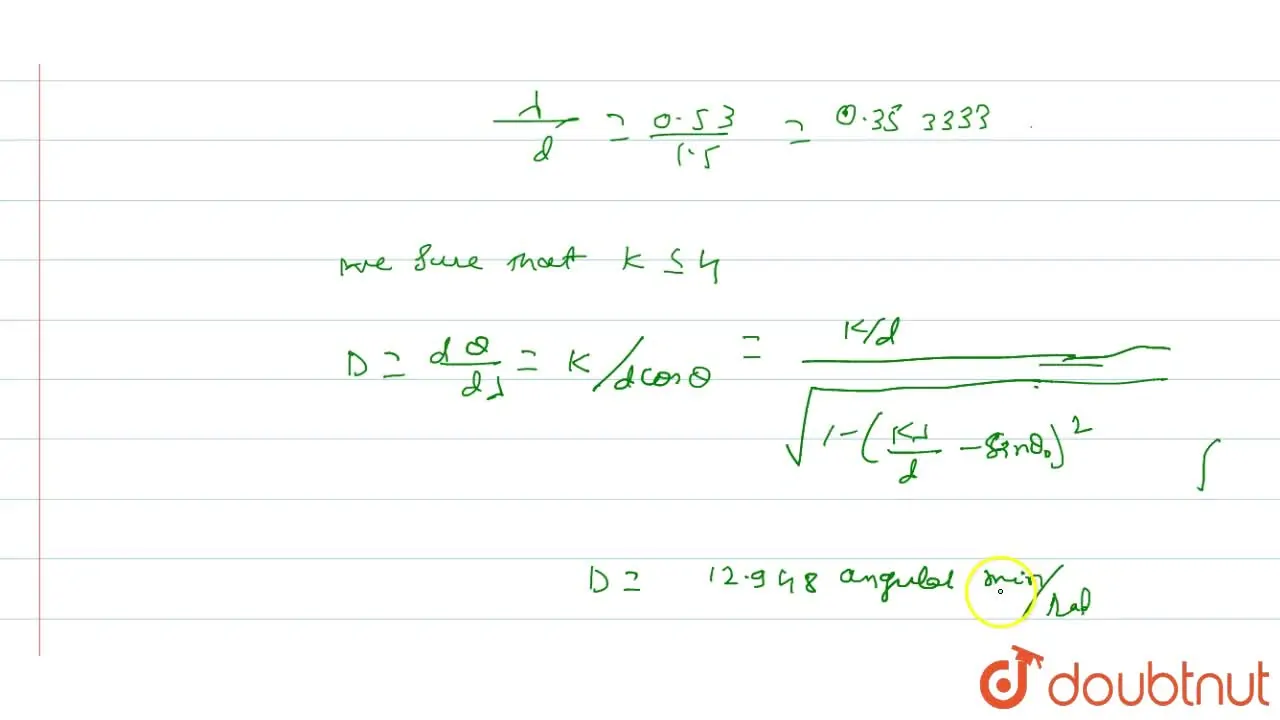A transparent diffraction grating has a period d=1.50μm. Find the angular disperison D (in angular minutes per nanometers) corresponding to the maximum of highest order for a spectral line of wavelength λ=530mm of light falling on the grating
(a) at right angles,
(b) at the angle θ0=45∘ to the normal.
For normal incidence, the maxima are given by
dsinθ=nλ
so sinθ=nλd=n×0.5301.500
Clearly n≤2 as sinθ>1 for n=3.
Thus the highest order is n=2. Then
D=dθdλ=kdcosθ=kd1√1−(kλd)2
Putting k=2,λ=0.53μm,d=1.5μm=1500nm
we get D=215001√1−(1.061.5)2×180π×60=6.47ang.min/nm.
(b) We write the diffraction formula as
d(sinθ0+sinθ)=kλ
so sinθ0+sinθ=kλd
Here θ0=45∘ and sinθ0=0.707
so sinθ0+sinθ≤1.707. Since
λd=0.531.5=0.353333, we see that
k≤4
Thus highest order corresponding to k=4.
Now as before D=dθdλso
D=kdcosθ=k/d√1−(kλd−sinθ0)2
=12.948ang.min/nm,
Related Playlists
- BOOK - IE IRODOV, LA SENA & SS KROTOVCHAPTER - OPTICSEXERCISE - Polarization Of Light43videos
OPTICS
- BOOK - IE IRODOV, LA SENA & SS KROTOVCHAPTER - OPTICSEXERCISE - Dispersion And Absorption Of Light24videos
OPTICS
- BOOK - IE IRODOV, LA SENA & SS KROTOVCHAPTER - OPTICSEXERCISE - Interference Of Light33videos
OPTICS
- BOOK - IE IRODOV, LA SENA & SS KROTOVCHAPTER - MECHANICSEXERCISE - Mechanics Problems92videos
MECHANICS
- BOOK - IE IRODOV, LA SENA & SS KROTOVCHAPTER - OSCILLATIONS AND WAVESEXERCISE - Electromagnetic Waves, Radiation36videos
OSCILLATIONS AND WAVES
Similar Questions
Light with wavelength 530nm falls on a transparent diffraction grating with period 1.50μm. Find the angle, relative to the grating normal. At which the Fraunhofer maximum of highest order is observed provided the light falls on the grating
(a) at right angles,
(b) at the angle 60∘ to the normal.View SolutionA transparent diffraction grating of a quartz spectrograph is 25mm wide and has 250 lines per millimetre. The focal length of an objective in whose focal plane a photographic plate is located is equal to 80cm. Light falls on the grating at right angles. The spectrum under investigating includes a doublet with components of wavelength 310.154 and 310.184nm. Determine:
(a) the disatnce on the photographic plate between the components of this doublet in the spectra of the first and the second order,
(b) whether these components will be resolved in these orders of the spectrum.View SolutionLight with wavelength 535nm falls normally on a diffraction grating. Find its period if the diffraction angle 35∘ corresponds to one of the Fraunhofer maxima and the highest order of spectrum is equal to five.
View SolutionLight with wavelength λ falls on a diffracting grating at right angles. Find the angular dispersion of the grating as a function of diffraction angle θ.
View SolutionDetermine the angular separation between central maximum and first order secondary maximum of the diffraction pattern due to a single slit of width 0.25mm when light of wavelength 5890Å falls on it normally.
View SolutionLight falls normally on a transparent diffraction grating of width l=6.5cm with 200 lines per millimetre. The spectrum under inverstigation includes a spectral line with λ=670.8nm consisting of two components differing by δλ=0.015nm. Find:
(a) in what order of the spectrum these components will be resolved,
(b) the least difference of wavelength that can be resolved by this grating in a wavelength region λ≈670nm.View SolutionA narrow beam of electrons passes immediately over the surface of a metallic mirror with a diffraction grating with period d=2.0μm inscribed on it. The electrons move with velocity v, comparable to c, at right angles to the lines of the grating. The trajectory of the electrons can be seen in the from of a strip, whose colouring depends on the observation angle θ (Fig.) Interpret this phenomenon. Find the wavelength of the radiations observed at an angle θ=45∘.
 View Solution
View SolutionA plane light wave with wavelength λ=0.50μm falls normally on the face of a glass wedge with an angle Θ=30∘. On the opposite face of the wedge a transparent diffraction grating with period, d=2.00μm is inscibed, whose lines are parallel to the wedge's edge. Find the angles that the direction of incident light froms with the directions to the principle Fraunhofer maxima of the zero and the first order. waht is the highest order of the spectrum? At what angle to the direction of incident light of the observed?
View SolutionA monochromatic beam falls on a reflection grating with period d=1.0mm at a glancing angle α0=1.0∘. When it is diffracted at a glancing angle α=3.0∘ a Fraunhofer maximum of second order occurs. Find the wavelength of light.
View SolutionWith light falling normally on a transparent diffraction grating 10mm wide, it was found that the components of the yellow line of sodium (589.0 and 589.6nm) are resolved beginning with the fifth order of the spectrum. Evaluate:
(a) the period of this grating,
(b) what must be the width of the grating with the same period for a double λ=460.0nm whose components differ by 0.13nm to be resolved in the third order of the spectrum.View Solution


